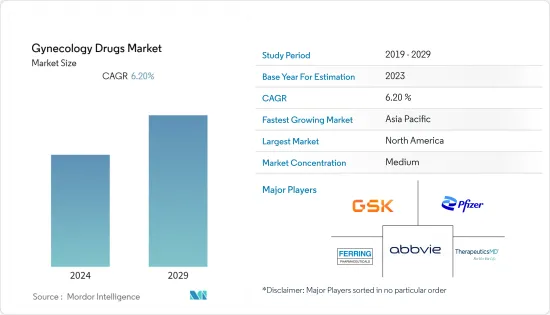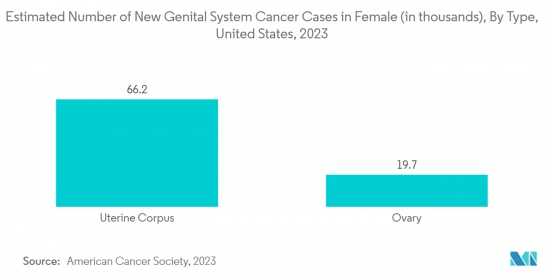
|
시장보고서
상품코드
1405701
부인과용 의약품 : 시장 점유율 분석, 산업 동향 및 통계, 성장 예측(2024-2029년)Gynecology Drugs - Market Share Analysis, Industry Trends & Statistics, Growth Forecasts 2024 - 2029 |
||||||
부인과용 의약품 시장은 예측 기간 동안 연평균 복합 성장률(CAGR) 6.2%로 성장할 것으로 예측됩니다.

주요 하이라이트
- COVID-19 팬데믹은 첫 팬데믹 시에 부인과 질환 환자의 관리에 상당한 영향을 미쳤습니다. 예를 들어, 2022년 8월에 SAGE Journals가 발표한 연구에 따르면, 팬데믹 기간 동안 부인과계 암의 관리는 봉쇄의 영향도 있고, 또한 COVID-19 환자의 관리에 자원을 돌렸던 부분도 있고, 고전을 강요당했습니다. 또한 팬데믹시 부인과계 암 관리의 수정이 권장된다고도 언급되어 있습니다. 이러한 사례로부터, 팬데믹 기간 동안 시장은 급증했다고 생각됩니다. 그러나 규제와 폐쇄가 완화되고 COVID-19의 사례가 감소함에 따라 시장은 예측 기간 동안 크게 성장할 것으로 예상됩니다.
- 조사 대상 시장의 성장을 가속하는 주요 요인으로는 부인과 질환의 부담 증가, 여성의 고령화와 함께 건강 의식 증가 등이 있습니다.
- 다양한 부인과 질환의 이환율 상승은 앞으로도 계속될 것으로 예측되고 있으며, 효율적인 치료에 대한 수요를 부추겨 예측 기간에 걸쳐 세계의 부인과용 의약품 시장을 견인할 것으로 보입니다. Cureus가 2022년 8월에 발표한 기사에 따르면, 인도에서 조사가 실시되었고, 조사 참가자 중 다낭성 난소 증후군(PCOS)의 유병률은 6.8%였습니다. 이 출처는 또한 다낭성 난소 증후군이 사춘기와 젊은 여성들 사이에서 매우 일반적인 건강 문제라고 말합니다. 따라서 이러한 질병의 부담이 큰 것이 시장의 성장을 밀어 올 것으로 예상됩니다.
- 게다가 2022년 1월에 미국 국립암 연구소가 발표한 데이터에 따르면, 2022년 미국에서의 신규 자궁 경부암 환자수의 추계치는 약 14,100명으로, 신규 암 환자수 전체의 약 0.7% 증가하고 있습니다. 마찬가지로 미국암협회가 2022년 1월 발표한 보고서에 따르면 2022년 새롭게 난소암 진단을 받는 여성은 약 19,880명으로 예상되고 있습니다. 따라서 이러한 부인과계 암의 높은 유병률은 부인과용 의약품 수요를 촉진하여 시장의 성장을 가속할 것으로 예상됩니다.
- 게다가 주요 시장 진출기업에 의한 새로운 전개도 시장의 성장을 뒷받침하고 있습니다. 예를 들어, 2021년 5월, Myovant Sciences사와 Pfizer Inc.는 폐경 전 여성의 자궁근종에 수반하는 월경 다량 출혈의 관리에 대한 최초의 1일 1회 치료제인 MYFEMBREE의 승인을 미국 식품의약품국( USFDA)에서 얻었습니다(치료 기간은 최대 24개월).
- 그러나 높은 비용과 제품 승인을 늦추는 엄격한 규제 체제는 예측 기간 동안 시장 성장을 방해할 가능성이 높습니다.
부인과용 의약품 시장 동향
비호르몬 치료 분야는 예측 기간 동안 고성장이 예상된다.
- 비 호르몬 요법 부문은 예측 기간 동안 높은 성장이 예상됩니다. 이 분야의 유리한 성장은 치료효율이 입증되고 있는 것, 부작용이 적은 신제품 개발이 급속히 진행되고 있는 것, 폭넓은 시장 제품이 입수가능하다는 점에서 이들 제품의 채용이 증가하고 있는 것에 기인합니다. 또한 호르몬 요법과 관련된 유방암 위험과 기타 합병증과 같은 단점이 예측 기간 동안 비 호르몬 요법 제품 수요를 촉진할 것으로 예상됩니다.
- 비 호르몬 요법의 효능과 이점을 측정하기 위해 다양한 연구가 수행되었습니다. 예를 들어, 2022년 3월에 PubMed에 의해 발표된 연구에 따르면, NLRP3/IL-1 휠은 자궁내막증의 병인에 관여하고 있으며, NLRP3 억제제는 난소자궁내막증의 억제나 자궁내막 증상이 있는 난소의 기능 개선에 유용할 수 있습니다.
- 또한 다양한 증상에 대한 새로운 비호르몬 요법제의 출시를 향한 임상시험 증가도 이 분야의 성장을 가속화하고 있습니다. 예를 들어, 2021년 10월, Bayer는 폐경기 혈관운동 증상의 치료에 대한 엘린자네탄트의 효능과 안전성을 평가하기 위한 3상 임상 개발 프로그램 OASIS를 시작했습니다.
- 따라서 비호르몬 요법에 관한 연구와 임상시험 증가에 의해 부인과계 암 치료에 있어서 비호르몬 요법의 적용에 대한 인식이 높아질 것으로 예상됩니다. 따라서 예측 기간 동안 상당한 성장이 예상됩니다.

북미가 부인과용 의약품 시장에서 큰 점유율을 차지할 전망
- 예측 기간 동안 북미는 부인과용 의약품 시장에서 큰 점유율을 차지할 것으로 보입니다. 이 우위성은 이 지역 여성의 바쁜 라이프스타일과 스트레스 증가로 유방암, 갱년기 장애, 다낭성 난소 증후군 등의 이환율이 상승하고 있는 것이 주된 이유입니다.
- 예를 들어, 캐나다 암 협회가 2022년 5월에 발표한 보고서에 따르면, 2022년에는 약 1,450명의 캐나다 여성이 자궁 경부암으로 진단된 것으로 나타났습니다. 또한 고도의 건강 관리 인프라 개발, 여성 건강 관리 의식 향상을 위한 정부 지출 증가, 노인 여성 인구 증가 및 외 지역의 품질 강화 제품이 조기에 출시되는 것도 예측 기간 동안 시장 성장에 기여할 것으로 예상됩니다.
- 주요 제품의 출시, 시장 기업와 제조업체의 프레즌스의 집중, 주요 기업간의 인수와 제휴, 미국에 있어서의 부인과계암의 유병률의 높이 등은 동지역의 부인과용 의약품 시장의 성장을 가속하는 요인의 일부입니다.
- 예를 들어, 미국 암 협회가 2022년 1월에 발표한 보고서에 따르면 유방암은 미국에서 여성에게 가장 많은 암이며, 매년 새롭게 발생하는 여성의 암의 약 30.0%, 3명 중 1명 유방암입니다. 이러한 높은 유병률은 부인과용 의약품 수요를 급증시킬 것으로 예상되며, 예측 기간 동안 미국에서 시장 성장을 가속합니다.
부인과용 의약품 산업 개요
부인과용 의약품 시장은 적당한 경쟁을 가지고 있으며, 여러 대형 기업들이 진입하고 있습니다. 이 시장의 일부 유력 기업은 신제품 출시 및 인수 등 다양한 전략을 실시하여 세계 시장에서의 지위를 굳히고 있습니다. 경쟁 구도으로는 Allergan Plc, Pfizer Inc, AbbVie Inc, TherapeuticsMD Inc, Ferring Holding SA 등 시장 점유율을 보유한 지명도가 높은 국제 기업 및 지역 기업 분석이 포함됩니다.
기타 혜택 :
- 엑셀 형식 시장 예측(ME) 시트
- 3개월간의 애널리스트 서포트
목차
제1장 서론
- 조사의 전제조건 및 시장 정의
- 조사 범위
제2장 조사 방법
제3장 주요 요약
제4장 시장 역학
- 시장 개요
- 시장 성장 촉진요인
- 부인과 질환의 부담 증가
- 여성의 고령화에 수반하는 헬스케어 의식의 고조
- 시장 성장 억제요인
- 약의 승인을 늦추는 고비용 및 엄격한 규제 틀
- Porter's Five Forces 분석
- 신규 참가업체의 위협
- 구매자 및 소비자의 협상력
- 공급기업의 협상력
- 대체품의 위협
- 경쟁 기업간 경쟁 관계의 강도
제5장 시장 세분화(시장 규모 및 금액 기준)
- 치료제별
- 호르몬 요법
- 비호르몬 요법
- 적응증별
- 부인과계 암
- 갱년기 장애
- 다낭성 난소 증후군
- 피임
- 기타 적응증
- 유통 채널별
- 병원 약국
- 소매 약국
- 온라인 약국
- 지역별
- 북미
- 미국
- 캐나다
- 멕시코
- 유럽
- 독일
- 영국
- 프랑스
- 이탈리아
- 스페인
- 기타 유럽
- 아시아태평양
- 중국
- 일본
- 인도
- 호주
- 한국
- 기타 아시아태평양
- 중동 및 아프리카
- GCC
- 남아프리카
- 기타 중동 및 아프리카
- 남미
- 브라질
- 아르헨티나
- 기타 남미
- 북미
제6장 경쟁 구도
- 기업 프로파일
- Pfizer Inc.
- AbbVie Inc.
- TherapeuticsMD Inc.
- Ferring Holding SA
- Lupin Pharmaceuticals Inc
- Johnson & Johnson
- Eli Lilly and Company
- Bayer AG
- GSK plc
- Abbott Laboratories Ltd.
- AstraZeneca
제7장 시장 기회 및 앞으로의 동향
AJY 24.01.23
The gynecology drugs market is expected to register a CAGR of 6.2% over the forecast period.
Key Highlights
- The COVID-19 pandemic considerably impacted the management of patients with gynecologic diseases during the initial pandemic. For instance, according to a study published by SAGE Journals in August 2022, the management of gynecological cancers suffered during the pandemic, partly due to lockdowns and partly due to directing resources to manage COVID-19 patients. It was also stated that modification of gynecological cancer management during the pandemic was recommended. Therefore, such instances indicated that the market witnessed slow growth during the pandemic. However, with the easing of restrictions and lockdowns and declining cases of COVID-19, the market was expected to witness considerable growth over the forecast period.
- The major factors driving the growth of the studied market include the increasing burden of gynecological diseases and the rise in healthcare awareness along with the increasing aging female population.
- The rising incidence of various gynecological diseases is projected to continue in the future, which is likely to fuel the demand for efficient treatment, driving the global gynecological drugs market over the forecast period. According to an article published by Cureus in August 2022, a study was conducted in India, which showed that the prevalence of polycystic ovary syndrome (PCOS) was 6.8% among the study participants. The source also stated that polycystic ovary syndrome is a very common health problem among adolescents and young girls. Thus, the high burden of such diseases is expected to boost the market growth.
- Moreover, according to the data published by the National Cancer Institute in January 2022, the estimated number of new cervical cancer cases in 2022 was around 14,100 in the United States, which is around 0.7% up from previous years of all new cancer cases. Similarly, as per the report published by the American Cancer Society in January 2022, around 19,880 women were expected to receive a new diagnosis of ovarian cancer in 2022. Therefore, such a high prevalence of gynecology cancers is expected to fuel the demand for gynecology drugs, thereby propelling the market growth.
- Moreover, the rising developments by key market players are also enhancing the market growth. For instance, in May 2021, Myovant Sciences and Pfizer Inc. received approval from the United States Food and Drug Administration (USFDA) for MYFEMBREE, the first once-daily treatment for the management of heavy menstrual bleeding associated with uterine fibroids in premenopausal women, with a treatment duration of up to 24 months.
- However, the high cost and stringent regulatory framework that delays the approval of products are likely to impede market growth over the forecast period.
Gynecology Drugs Market Trends
Non-hormonal Therapy Segment is Expected to Witness High Growth Over the Forecast Period
- The non-hormonal therapy segment is expected to have a high growth rate over the forecast period. The lucrative growth of the segment can be attributed to the rise in the adoption of these products due to proven efficiency in the treatment, rapid advancements in new product development with reduced side effects, and the availability of a wide range of marketed products. Furthermore, the disadvantages of hormonal therapy, such as the risk of breast cancer and other complications associated with these products, are expected to foster the demand for non-hormonal products during the forecast period.
- Various studies are being conducted to measure the effectiveness and advantages of non-hormonal therapy. For instance, according to the study published by PubMed in March 2022, NLRP3/IL-1β is involved in the pathogenesis of endometriosis, and the NLRP3 inhibitor may be useful for suppressing ovarian endometriosis and improving the function of ovaries with endometriosis.
- In addition, increasing clinical trials for launching new non-hormonal therapy drugs for various symptoms are also surging the segment growth. For instance, in October 2021, Bayer commenced the Phase III clinical development program OASIS, which aims to evaluate the efficacy and safety of elinzanetant for the treatment of vasomotor symptoms during menopause.
- Therefore, increasing studies on non-hormonal therapy and clinical trials are expected to increase awareness of the application of non-hormonal therapy in treating gynecological cancers. Hence, significant segment growth is anticipated over the forecast period.

North America is Expected to Hold a Significant Share in the Gynecology Drugs Market
- North America is expected to hold a significant share of the gynecology drugs market over the forecast period. This dominance is mainly owing to rising incidences of breast cancer, menopausal disorders, polycystic ovary syndrome, and others due to busy lifestyles and the rise in stress among the women in the region.
- For instance, as per the report published by the Canadian Cancer Society in May 2022, it is estimated that around 1,450 Canadian women will be diagnosed with cervical cancer in 2022. Moreover, the availability of advanced healthcare infrastructure, an increase in government expenditure for women's healthcare awareness, and the senior women population, along with early product launches with enhanced quality in the region, are expected to contribute to the market growth over the forecast period.
- Key product launches, high concentration of market players or manufacturers' presence, acquisition and & partnerships among major players, and the high prevalence of gynecological cancers in the United States are some of the factors driving the growth of the gynecology drugs market in the region.
- For instance, as per the report published by the American Cancer Society in January 2022, breast cancer is the most common cancer in women in the United States, which is about 30.0% or 1 out of 3 of all new female cancers each year. Such high prevalence is anticipated to surge the demand for gynecology drugs, thereby propelling the market growth in the United States over the forecast period.
Gynecology Drugs Industry Overview
The gynecology drugs market is moderately competitive and consists of several major players. Some prominent players in the market are implementing various strategies, such as launching new products and making acquisitions to consolidate their market positions across the globe. The competitive landscape includes an analysis of a few international as well as local companies that hold the market shares and are well known, including Allergan Plc, Pfizer Inc, AbbVie Inc, TherapeuticsMD Inc, and Ferring Holding SA, among others.
Additional Benefits:
- The market estimate (ME) sheet in Excel format
- 3 months of analyst support
TABLE OF CONTENTS
1 INTRODUCTION
- 1.1 Study Assumptions and Market Definition
- 1.2 Scope of the Study
2 RESEARCH METHODOLOGY
3 EXECUTIVE SUMMARY
4 MARKET DYNAMICS
- 4.1 Market Overview
- 4.2 Market Drivers
- 4.2.1 Increasing Burden of Gynecological Diseases
- 4.2.2 Rise in Healthcare Awareness Along with Increasing Ageing Female Population
- 4.3 Market Restraints
- 4.3.1 High Cost and Stringent Regulatory Framework that Delays the Approval of the Drugs
- 4.4 Porter's Five Forces Analysis
- 4.4.1 Threat of New Entrants
- 4.4.2 Bargaining Power of Buyers/Consumers
- 4.4.3 Bargaining Power of Suppliers
- 4.4.4 Threat of Substitute Products
- 4.4.5 Intensity of Competitive Rivalry
5 MARKET SEGMENTATION (Market Size by Value - USD)
- 5.1 By Therapeutics
- 5.1.1 Hormonal Therapy
- 5.1.2 Non-hormonal Therapy
- 5.2 By Indication
- 5.2.1 Gynecology Cancers
- 5.2.2 Menopausal Disorder
- 5.2.3 Polycystic Ovary Syndrome
- 5.2.4 Contraception
- 5.2.5 Other Indications
- 5.3 By Distribution Channel
- 5.3.1 Hospital Pharmacies
- 5.3.2 Retail Pharmacies
- 5.3.3 Online Pharmacies
- 5.4 Geography
- 5.4.1 North America
- 5.4.1.1 United States
- 5.4.1.2 Canada
- 5.4.1.3 Mexico
- 5.4.2 Europe
- 5.4.2.1 Germany
- 5.4.2.2 United Kingdom
- 5.4.2.3 France
- 5.4.2.4 Italy
- 5.4.2.5 Spain
- 5.4.2.6 Rest of Europe
- 5.4.3 Asia-Pacific
- 5.4.3.1 China
- 5.4.3.2 Japan
- 5.4.3.3 India
- 5.4.3.4 Australia
- 5.4.3.5 South Korea
- 5.4.3.6 Rest of Asia-Pacific
- 5.4.4 Middle East and Africa
- 5.4.4.1 GCC
- 5.4.4.2 South Africa
- 5.4.4.3 Rest of Middle East and Africa
- 5.4.5 South America
- 5.4.5.1 Brazil
- 5.4.5.2 Argentina
- 5.4.5.3 Rest of South America
- 5.4.1 North America
6 COMPETITIVE LANDSCAPE
- 6.1 Company Profiles
- 6.1.1 Pfizer Inc.
- 6.1.2 AbbVie Inc.
- 6.1.3 TherapeuticsMD Inc.
- 6.1.4 Ferring Holding SA
- 6.1.5 Lupin Pharmaceuticals Inc
- 6.1.6 Johnson & Johnson
- 6.1.7 Eli Lilly and Company
- 6.1.8 Bayer AG
- 6.1.9 GSK plc
- 6.1.10 Abbott Laboratories Ltd.
- 6.1.11 AstraZeneca

















